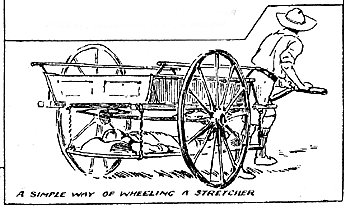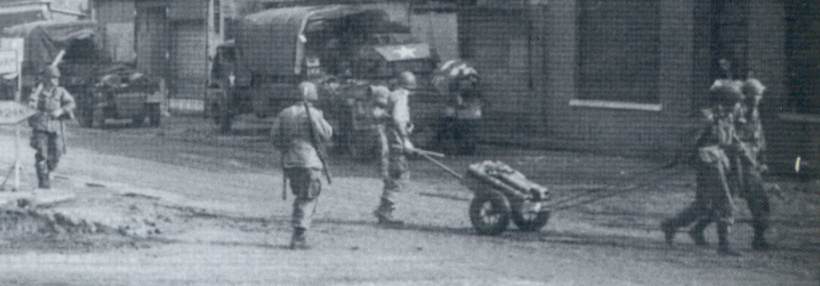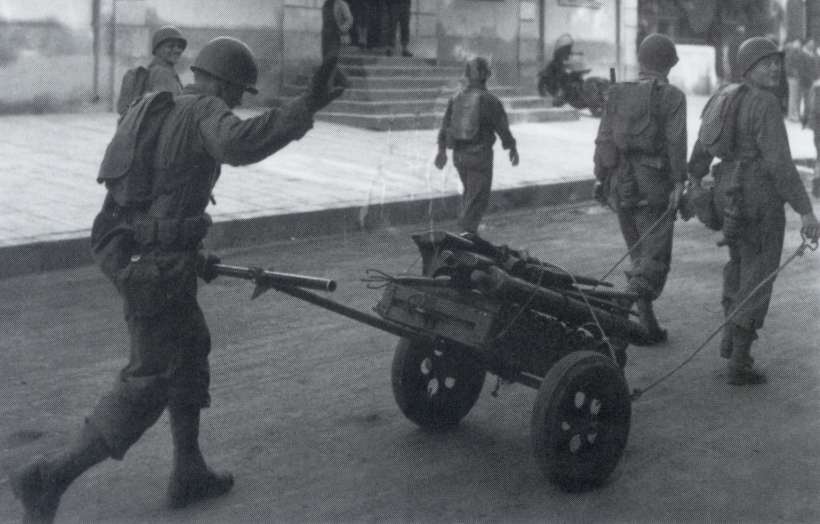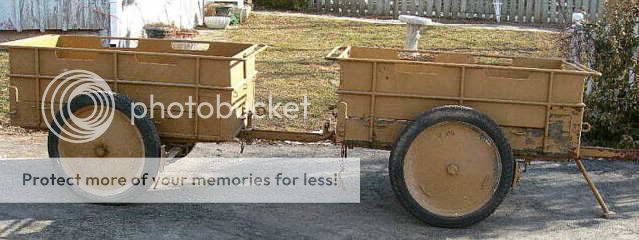The last couple of posts have been on martial arts so today’s will be more survival orientated.
Recently I saw a comedian who commented:
“We put men on the moon decades before we thought of putting wheels on suitcases.”
I have been researching a few other topics that are out of the scope of this blog but a common thread that keeps turning up is that of handcarts.
There was a time when every scout troop had at least one handcart to move their tents and supplies. Many of these would have been made by the troop themselves. Below is a rather nice illustration of a stretcher case suspended below a handcart. Perhaps the Scoutmaster was having a nap.
When 3,000 Mormons chose to migrate to Utah in the 19th century they travelled in companies of handcarts. Some of these families came from as far away as the British Isles and Scandinavia.
I have come across many photographs of handcarts in use during the Second World War. This is a nice webpage on the US military handcart. A couple of these could ride on the flatbed of a truck and still leave room for a squad or two of troops seated on the side benches. Handcarts are shown towed behind jeeps or riding in the cargo area of the jeep.
The picture below depicts a 1944 USMC machine gun section, and you can clearly see they had a handcart as standard equipment for each squad. As an aside, I note the 1944 MG squad had seven men and a handcart to service one M1919 MG. With one leader, a gunner and an assistant gunner that leaves four men to carry ammo and for local defence. An equivalent unit these days has two MGs, seven men and no cart, which implies only one ammo bearer per gun. Modern troops are probably vehicle mounted but that is no comfort if you have to move the MG and ammo more than a few metres.
The German army also made use of handcarts. These were designed so they could be towed by men, horses, mules, dogs or vehicles and even had their own tow hooks so a train of them could be constructed.
One thing that you notice about the military handcarts is that they are quite narrow. This is logical since the main place you would want them is where you cannot take a vehicle. The handcart must be narrow enough to navigate a jungle trail or mountain path. A “T” shaped shaft seems standard for military handcarts, probably since it can be more easily disengaged from than the “rickshaw” style of two shafts and a crossbar.
For some reason, modern outdoorsmen and Soldiers overlook the utility of a simple handcart. Some of you reading this blog will have created bug-out bags and perhaps even supply caches. How much better would your chances be if you also had a nearby handcart of additional supplies, water and equipment?
If you are building or buying a handcart there are obviously a number of features to look for. We have mentioned the T-shaft and that narrowness is a desirable characteristic. Ideally a loaded military handcart should not be so heavy that a couple of men cannot lift it over an obstacle. If you are on your own you may want something lighter. Being able to float the cart across a river is a desirable design feature. Some carts I have seen are narrow but about five feet long, making them suitable for transporting an injured companion in an emergency. It may be useful if you can convert your handcart into a sled or pulk when weather requires. In fact a sled or pulk may be a good starting point for a handcart construction project.
I’ll end this discourse by looking at a few interesting alternatives to the handcart. Wheelbarrows can be used as emergency handcarts. They have the merit that in some neighbourhoods they are fairly common. An extension of this idea is the Chinese big wheel wheelbarrow. You may need some skill distributing the load in a balanced fashion but it is evident these can handle heavy loads and quite rough terrain.
Another alternative is the Christiania Bike. (I know it is a trike, but they are usually called bikes!). If you have visited Copenhagen you will know these are a common sight in that city. Young Danish mothers use them to transport their children to school and then pick up a heavy load of shopping. After dark you sometimes see drunk couples returning home in a Christiania bike. This culture of cycling everywhere may explain why nearly every second woman in Copenhagen is worth a second look! The Christiania bikes are very nicely designed. In most of them the large box at the front contains a smaller box that serves as both a seat for passengers and a locked storage compartment. The Christiania “as is” is not really designed for rough terrain but the basic idea could be adapted to use mountain bike tires and gearing. Add a few lifting handles. One might even design it so that it can be towed like a handcart when possible.
If you have enjoyed this article or it has been helpful to you please feel free to show your appreciation. Thank you.
The Books



















